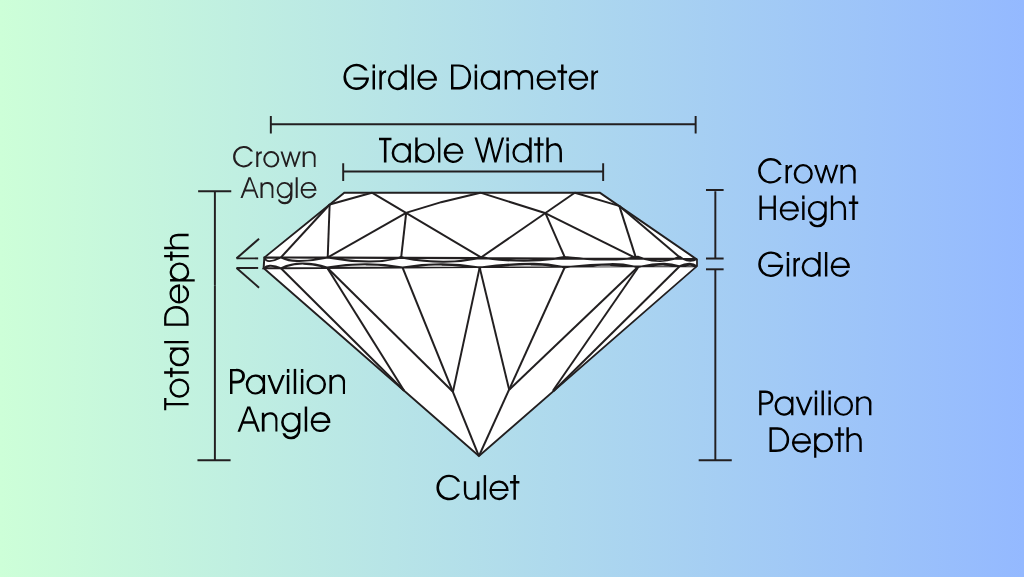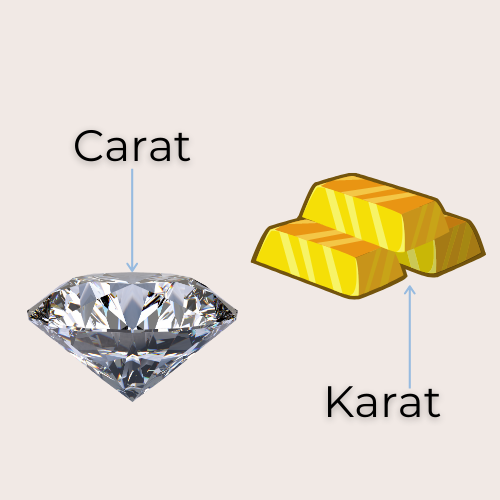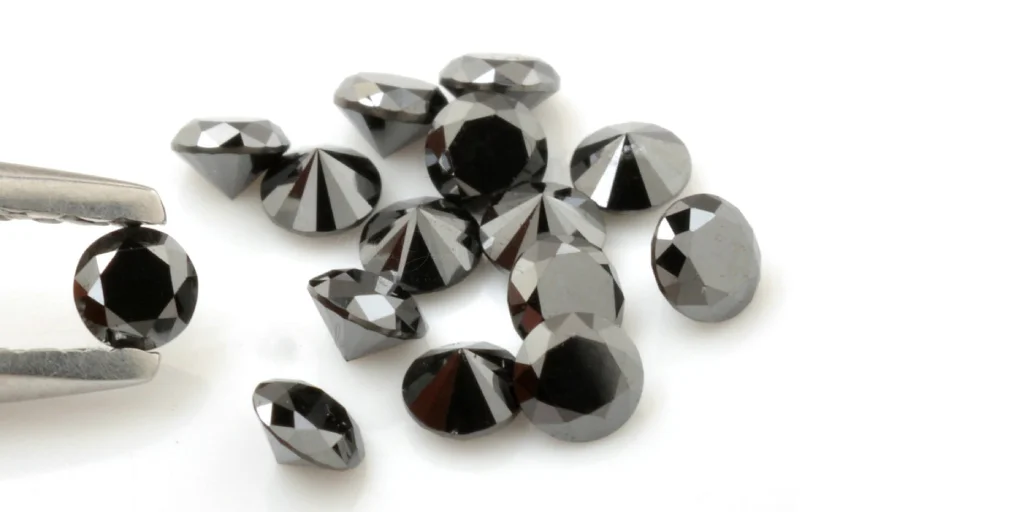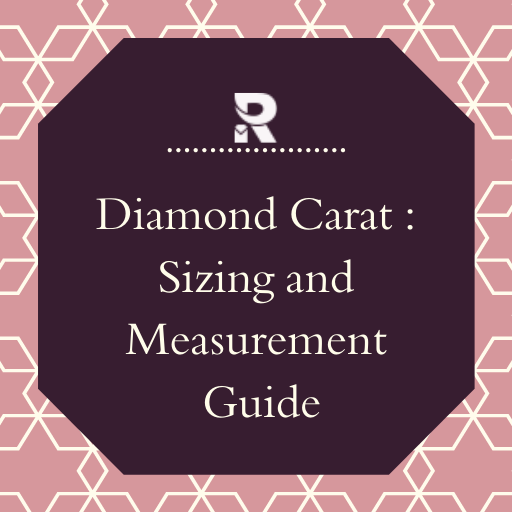
A carat is the unit of measurement for the weight of diamonds. One carat of a diamond is quantified as 200mg. It is perhaps the first parameter considered when purchasing a diamond. In the United States, one carat equals 0.007-ounce avoirdupois. One carat is subdivided into 100 points allowing precise measurements to the hundredth decimal place.
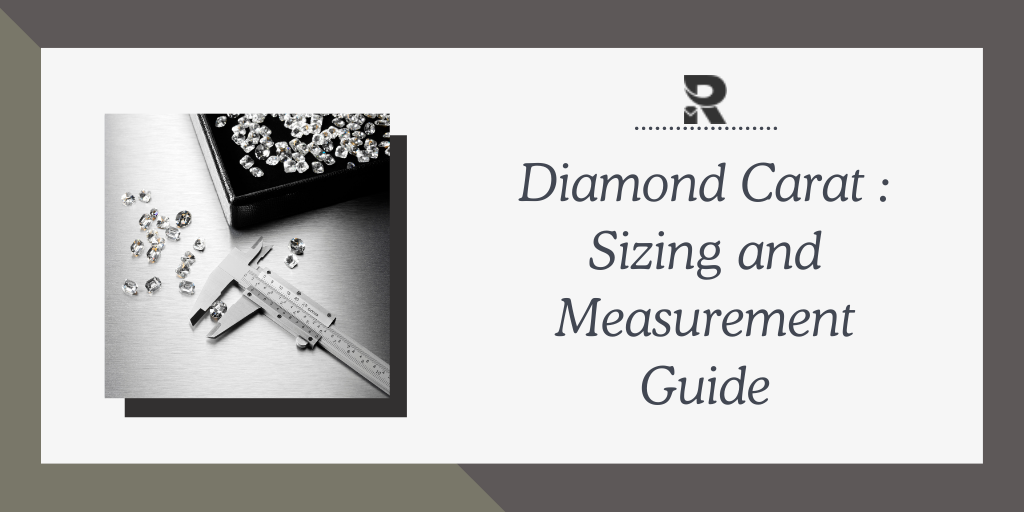
A jeweler at any store you visit may describe the weight of a diamond solely by its points. For example, a diamond that weighs 0.25 carats may be referred to as a twenty-five-pointer diamond. And a diamond that weighs more than one carrot, say 1.08-carat diamond would be referred to as one point oh eight carats.
The diamond carat is one of the positive traits out of the 4c’s. Among the 4c’s you do not really notice the color of the diamond at first sight rather you notice its dimensions and the clarity of the diamonds, i.e., how well can it reflect light based on its faceting.
HOW DID THE CARAT SYSTEM BEGIN?
It started with the carob seed. The early gem traders used small, uniform seeds as counterweights for their balance scales. A carat in today’s terms is the same as the milligram weight.
VALUE OF A DIAMOND CARAT
The value of a diamond increases with its carat weight since larger diamonds are rarer in nature and difficult to procure. However, two diamonds of the same carat having different characteristics may differ in value. The sum value of a diamond is set considering the 4c’s (Cut, Carat, Color, and Clarity). A great quality one carat diamond in a “platinum solitaire” set costs approximately $12,000 – $15,000.
IMPORTANCE OF A DIAMOND’S MM MEASUREMENT
Also Read: Diamond Color: Color Chart And Complete Buying Guide
An mm measurement provides the “true size” of a diamond because a diamond’s true size may be camouflaged by its faceting. For example, emerald, oval and pear-shaped diamonds, all despite having the same carat look larger compared to a round cut diamond. The weight of a diamond is paramount as it helps you to understand how much you will be paying for the diamond. About the design of your selected jewelry and to get the most out of your money the diamond’s cut grade and diameter are the most important.
The carat weight and the millimeter measurements are found on the diamond certification issued by GIA. (Gemological Institute of America) and IGI certifications are release for lab-manufactured diamonds.
CORRELATION BETWEEN CARAT AND DIAMETER
There is a direct correlation between the diameter of a diamond and the carat of a diamond. A 0.5ct diamond cannot have a surface area of more than 1-carat diamond. However, there is an enormous range of variation in diameter and qualities available for a given carat.
MAGIC SIZES OR CRITICAL WEIGHTS
Weights such as half a carat (0.5ct), three-quarter carat (0.75ct), and one carat (1.00ct) are considered magic sizes because as soon as you move just one carat above these, their price also “magically” jumps up. This is mainly because a 0.96 carat does not have the same ring as a one-carat diamond. Hence if your diamonds are half a carat, three-quarter, or one carat then you may be able to easily brag about it at the next family gathering, while paying significantly more. These sell faster on the market and have high demand rates compared to other carat diamonds, as a result, these are considered rarer and consequently pricier than the rest.
But if you are a person who values quality over quantity then you would realize that a 0.96 carat diamond with the right cut would be visibly the same as the diamond with any one of the “magical sizes”.
HOW TO CHOOSE THE BEST DIAMOND
- Go for the diamond with the lowest color (near colorless diamonds are most preferred)
- Select the lowest category that still looks bright, when upright under the naked eye.
- The carat weight can be the highest within your budget.
- Try to avoid the “magic weights”.
- Keep in mind that the right cut can enhance your carat weight or dimmish it.
- The metal you choose to mount the diamond in can also affect the overall view of the diamond. To get the most of your money, you must select a diamond in which all the 4c’s complement each other.
DIAMOND SIZE CHARTS
“ROUND DIAMOND”
The is the most sought-after shape for engagement rings. Their versatility and Victorian aesthetics make them ideal. It comes with a proportional cut with 57 facets.
| CARAT (CT) | Diameter (mm) |
| 0.25 ct. | 4 mm |
| 0.5 ct. | 5.1 mm |
| 0.75 ct. | 5.8 mm |
| 1 ct. | 6.4 mm |
| 1.25 ct. | 6.9 mm |
| 1.5 ct. | 7.3 mm |
| 1.75 ct. | 7.7 mm |
| 2 ct. | 8.1 mm |
| 2.25 ct. | 8.5 mm |
| 2.5 ct. | 8.9 mm |
| 2.75 ct. | 9 mm |
| 3 ct. | 9.3 mm |
| 3.25 ct. | 9.5 mm |
| 3.5 ct. | 9.75 mm |
| 3.75 ct. | 9.9 mm |
| 4 ct. | 10.1 mm |
| 4.25 ct. | 10.43 mm |
| 4.5 ct. | 10.63 mm |
| 4.75 ct. | 10.83 mm |
| 5 ct. | 11.01 mm |
“PRINCESS DIAMOND”
These are considered the next best thing to round-cut diamonds. They are a perfect square which is a beautiful and unique contrast to round cut diamonds. This cut is also considerably less expensive compared to round cut diamonds.
| CARAT (CT) | Diameter (mm) |
| 0.015 ct. | 1.5 mm |
| 0.03 ct. | 1.75 mm |
| 0.06 ct. | 2.00 mm |
| 0.08 ct. | 2.25 mm |
| 0.10 ct. | 2.50 mm |
| 0.13 ct. | 2.75 mm |
| 0.18 ct. | 3.00 mm |
| 0.26 ct. | 3.25 mm |
| 0.29 ct. | 3.50 mm |
| 0.31 ct. | 3.75 mm |
| 0.39 ct. | 4.00 mm |
| 0.44 ct. | 4.25 mm |
| 0.50 ct. | 4.50 mm |
| 0.64 ct. | 4.75 mm |
| 0.75 ct. | 5.00 mm |
| 0.75 ct. | 5.25 mm |
| 1.00 ct. | 5.50 mm |
| 1.11 ct. | 5.75 mm |
| 1.25 ct. | 6.00 mm |
| 1.39 ct. | 6.25 mm |
| 1.50 ct. | 6.5 mm |
| 1.75 ct. | 6.75 mm |
| 2 ct. | 7 mm |
“CUSHION DIAMOND”
The cushion diamond is ranked as one of the five most popular cut of the diamond. It is a cut that stands somewhere between the round cut and the princess cut. It is a cut that would appeal more to your vintage tastes and is preferred by royals and celebrities.
| Carat Weight | MM Size |
| 0.40 ct. | 4.2 mm |
| 0.50 ct. | 4.9 mm |
| 0.75 ct. | 5.25 mm |
| 1.00 ct. | 5.5 mm |
| 1.25 ct. | 6 mm |
| 1.50 ct. | 6.5 mm |
| 2.00 ct. | 7 mm |
| 2.50 ct. | 7.5 mm |
| 3.00 ct. | 8 mm |
| 3.50 ct. | 8.5 mm |
| 4.12 ct. | 9 mm |
| 5.09 ct. | 9.5 mm |
| 5.62 ct. | 10 mm |
| 7.44 ct. | 11 mm |
| 9.52 ct. | 12 mm |
| 12.6 ct. | 13 mm |
Also Read: What Is Good Cut Quality For Sparkling Diamond
“EMERALD DIAMOND”
The shapes of these kinds of diamonds resemble those of rectangular-shaped gems, these just have softer and rounder edges. These are also suitable for vintage-styled antique jewelry.
| Carat Weight | MM Size |
| 0.10 ct. | 3×2 mm. |
| 0.12 ct. | 3.5×2 mm. |
| 0.15 ct. | 4×2 mm. |
| 0.20 ct. | 4×3 mm. |
| 0.29 ct. | 5×3 mm. |
| 0.46 ct. | 5.5×3.5 mm. |
| 0.50 ct. | 6×4 mm. |
| 0.75 ct. | 6.5×4.5 mm. |
| 0.88 ct. | 6.5×4.5 mm. |
| 1.00 ct. | 7×5 mm. |
| 1.25 ct. | 7.3×5.3 mm. |
| 1.50 ct. | 7.5×5.5 mm. |
| 1.75 ct. | 8×6 mm. |
| 2.00 ct. | 8.5×6.5 mm. |
| 2.50 ct. | 9×7 mm. |
| 3.00 ct. | 10×7.5 mm. |
| 3.21 ct. | 9.5×7.5 mm. |
| 3.79 ct. | 10×8 mm. |
| 5.21 ct. | 11×9 mm. |
| 5.34 ct. | 12×8 mm. |
| 6.00 ct. | 12×10 mm. |
| 6.25 ct. | 14×8 mm. |
| 6.38 ct. | 13×9 mm. |
| 8.48 ct. | 14×10 mm. |
| 9.13 ct. | 13×11 mm. |
| 11.26 ct. | 14×12 mm. |
| 14.22 ct. | 16×12 mm. |
| 16.50 ct. | 17×13 mm. |
“OVAL DIAMONDS”
This style is preferred for unique, non-trendy jewelry. These have an elongated shape similar to that of the emerald cut. The brightness of these diamonds increases as carat size increases.
| Carat Weight | MM Size |
| 0.21 ct. | 4.5×3.5 mm. |
| 0.21 ct. | 5×3 mm. |
| 0.33 ct. | 5.5×3.5 mm. |
| 0.35 ct. | 5×4 mm. |
| 0.50 ct. | 6×4 mm. |
| 0.61 ct. | 6×5 mm. |
| 0.65 ct. | 6.5×4.5 mm. |
| 0.75 ct. | 7×5 mm. |
| 1.00 ct. | 7.7×5.7 mm. |
| 1.25 ct. | 8×6 mm. |
| 1.41 ct. | 9×6 mm. |
| 1.50 ct. | 8.5×6.5 mm. |
| 2.00 ct. | 9×7 mm. |
| 2.50 ct. | 10×8 mm. |
| 2.88 ct. | 10.5×8.5 mm. |
| 3.00 ct. | 12×8 mm. |
| 3.85 ct. | 11×9 mm. |
| 5.05 ct. | 12×10 mm. |
| 5.81 ct. | 14×10 mm. |
| 6.05 ct. | 13×11 mm. |
| 8.21 ct. | 14×12 mm. |
| 8.76 ct. | 15×12 mm. |
| 9.32 ct. | 16×12 mm. |
| 11.88 ct. | 16×14 mm. |
| 12.86 ct. | 18×13 mm. |
| 14.96 ct. | 20×15 mm. |
“PEAR SHAPED DIAMONDS”
Pear cut diamonds are more commonly referred to as “teardrop”. These are quite similar to oval cut diamonds, hence also very unique. These are more commonly used for unique or traditional jewelry pieces. Their usage can be more commonly seen in earrings and solitaire necklaces. These are less used as engagement rings compared to the other cuts and carats.
| Carat Weight | MM Size |
| 0.13 ct. | 3×2 mm. |
| 0.18 ct. | 4×2.5 mm. |
| 0.21 ct. | 4×3 mm. |
| 0.25 ct. | 5×3 mm. |
| 0.35 ct. | 5×4 mm. |
| 0.50 ct. | 6×4 mm. |
| 0.60 ct. | 6.5×4.5 mm. |
| 0.75 ct. | 7×5 mm. |
| 0.85 ct. | 7.5×5.5 mm. |
| 1.00 ct. | 7.7×5.7 mm. |
| 1.25 ct. | 8×6 mm. |
| 1.50 ct. | 8.5×6.5 mm. |
| 1.71 ct. | 10×6 mm. |
| 1.80 ct. | 8.7×6.7 mm. |
| 2.00 ct. | 9×7 mm. |
| 2.50 ct. | 10×8 mm. |
| 2.61 ct. | 11×7.50 mm. |
| 2.98 ct. | 13×8 mm. |
| 3.00 ct. | 11×8 mm. |
| 3.00 ct. | 12×8 mm. |
| 3.12 ct. | 12×7 mm. |
| 3.44 ct. | 12×9 mm. |
| 3.47 ct. | 14×8 mm. |
| 4.11 ct. | 13×9 mm. |
| 4.25 ct. | 14×9 mm. |
| 5.06 ct. | 15×9 mm. |
| 5.41 ct. | 14×10 mm. |
| 5.65 ct. | 13×11 mm. |
| 5.75 ct. | 15×10 mm. |
| 5.86 ct. | 16×9 mm. |
| 6.27 ct. | 16×10 mm. |
| 6.46 ct. | 17×10 mm. |
| 7.36 ct. | 15×11 mm. |
| 8.14 ct. | 18×11 mm. |
| 8.99 ct. | 16×12 mm. |
| 9.35 ct. | 18×12 mm. |
| 10.21 ct. | 18×13 mm. |
| 11.70 ct. | 19×14 mm. |
“MARQUISE DIAMOND”
Marquise diamonds or more commonly referred to as “football diamonds” is perhaps one of the most prevalent in the vintage jewelry collection. This cut makes your diamond look bigger despite its carat as it is not uncommon for it to have nearly 50 to 60 facets. However, its versatile nature allows us to change the number of facets on the stone quite variably.
| Carat Weight | MM Size |
| 0.025 ct. | 3×1.5 mm. |
| 0.065 ct. | 3.5×1.75 mm. |
| 0.07 ct. | 3.5×2 mm. |
| 0.10 ct. | 4×2 mm. |
| 0.11 ct. | 3.75×1.75 mm. |
| 0.12 ct. | 4.25×2.25 mm. |
| 0.14 ct. | 5×2.5 mm. |
| 0.16 ct. | 5.5×2.75 mm. |
| 0.18 ct. | 5.5×3 mm. |
| 0.20 ct. | 5×3 mm. |
| 0.23 ct. | 6.5×3 mm. |
| 0.25 ct. | 6×3 mm. |
| 0.30 ct. | 7×3 mm. |
| 0.33 ct. | 7.5×3.5 mm. |
| 0.34 ct. | 7×4 mm. |
| 0.50 ct. | 8×4 mm. |
| 0.70 ct. | 8.75×4.25 mm. |
| 0.75 ct. | 9×4.5 mm. |
| 0.85 ct. | 9.5×2 mm. |
| 1.00 ct. | 10×5 mm. |
| 1.25 ct. | 11×5.5 mm. |
| 1.33 ct. | 11.5×6 mm. |
| 1.50 ct. | 12×6 mm. |
| 2.00 ct. | 13×6.5 mm. |
| 2.50 ct. | 14×7 mm. |
| 3.00 ct. | 15×7 mm. |
| 3.00 ct. | 14×8 mm. |
| 3.25 ct. | 15×7.5 mm. |
| 3.44 ct. | 15×8 mm. |
| 3.86 ct. | 16×8 mm. |
| 4.00 ct. | 16.5×8.25 mm. |
| 4.88 ct. | 17×8.5 mm. |
| 5.50 ct. | 17.5×10 mm. |
| 7.08 ct. | 20×8 mm. |
| 7.94 ct. | 20×10 mm. |
| 9.50 ct. | 20×11 mm. |
“ASSCHER CUT DIAMOND”
These diamonds are similar in cut to that of emerald-cut diamonds. However, these are more squared compared to the rectangle of emeralds. This cut supports large step facets or layered facets and a high crown; hence this shines brighter than most diamonds. They give a very raw diamond taste compared to other cuts.
| Carat Weight | MM Size |
| 0.39 ct. | 4 mm. |
| 0.50 ct. | 4.5 mm. |
| 0.75 ct. | 5 mm. |
| 1.00 ct. | 5.5 mm. |
| 1.25 ct. | 6 mm. |
| 1.50 ct. | 6.5 mm. |
| 2.00 ct. | 7 mm. |
| 2.50 ct. | 7.5 mm. |
| 3.00 ct. | 8 mm. |
| 3.50 ct. | 8.5 mm. |
| 4.12 ct. | 9 mm. |
| 5.09 ct. | 9.5 mm. |
| 5.62 ct. | 10 mm. |
| 7.44 ct. | 11 mm. |
| 9.52 ct. | 12 mm. |
| 12.66 ct. | 13 mm. |
Also Read: Why Are Pink Diamond So Rare And Exclusive?
“RADIANT CUT DIAMOND”
This cut of a diamond can be best referred to as a combination diamond as it is somewhere between an emerald, round and Ascher cut. It is also often referred to as the “modified rectangle”. It’s definitely one of the most modern cuts out of all. Their best feature is that the other characteristics of the diamond do not have much variation with different carat weights.
| Carat Weight | MM Size |
| 0.31 ct. | 5×3 mm. |
| 0.34 ct. | 4.5×3.5 mm. |
| 0.41 ct. | 6×3 mm. |
| 0.50 ct. | 6×4 mm. |
| 0.75 ct. | 6.5×4.5 mm. |
| 1.00 ct. | 7×5 mm. |
| 1.25 ct. | 7.3×5.5 mm. |
| 1.50 ct. | 7.5×5.8 mm. |
| 2.00 ct. | 8×6 mm. |
| 2.25 ct. | 8.5×6.5 mm. |
| 2.50 ct. | 9×7 mm. |
| 3.00 ct. | 9.5×7.5 mm. |
| 3.31 ct. | 10×7 mm. |
| 3.50 ct. | 10×8 mm. |
| 5.05 ct. | 11×9 mm. |
| 6.06 ct. | 12×9 mm. |
| 6.45 ct. | 11.5×10 mm. |
| 6.54 ct. | 13×9 mm. |
| 6.79 ct. | 12×10 mm. |
| 8.47 ct. | 14×10 mm. |
| 9.33 ct. | 13×11 mm. |
| 10.19 ct. | 13.5×11.5 mm. |
| 11.48 ct. | 15×11 mm. |
| 12.14 ct. | 14×12 mm. |
| 14.22 ct. | 16×12 mm. |
| 16.22 ct. | 17×13 mm. |
Conclusion Thoughts
A well-cut diamond will complement and enhance your choice of a carat weight as tend to have less depth and more evenly spread, giving them the appearance of a diamond larger than their carat weight. Magic Weights best be avoided. Purchasing a diamond with a carat weight below the cut-off weight will save you a significant amount of cash. The visual difference between a 1.40ct and a 1.50ct is almost negligible and cannot be noticed unless examined by an expert. Their difference may be negligible, but their cost difference would save you a lot of money.
